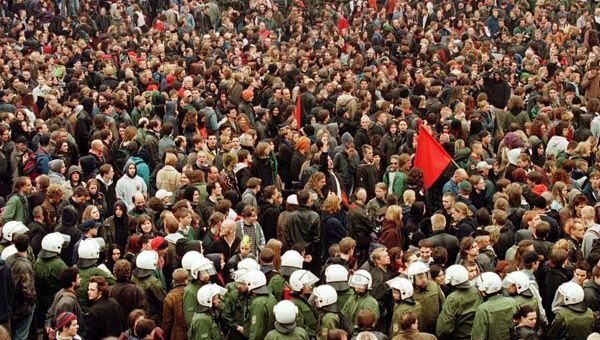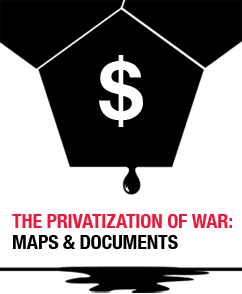For over 100 years May Day has been celebrated by workers, socialists, anarchists, autonomists, and a myriad of other radicals.
Revolutionary May Day in Berlin: It Began with a Riot

May Day is International Workers Day. It is celebrated every year by tens of millions of people in most countries around the world. It is an official holiday in all but a few countries, the US being one of the few to not recognize it. It originated with the struggle for the eight-hour workday, and in particular with the experience of police repression against workers in Chicago in 1886. For over 100 years it has been celebrated by workers, socialists, anarchists, autonomists and a myriad of other radicals. Over the years the participation of workers and radicals has gone up and down for various reasons, from repression to union bureaucracy. The later 1980s marks an upward shift in May Day celebrations to one that increasingly encompasses more diverse participants and movements, with May Day currently standing for everything from immigrant rights, social justice and the rights of the precarious to being against capitalist globalization and war. While in most of the global south May Day never lost its appeal as a significant day for struggle, both with militant resistance, as well as joyous celebrations, in the global north it is only in the past two decades that is has been increasingly reclaimed from below. May Day is also being recuperated as day of joy, of celebrating together the vast diversity of protagonists and participants, and of the changes to come – it is a moment where one catch a glimpse of tomorrow. The below article focuses on Revolutionary May Day in Berlin, as described by Dario Azzellini, who has been participating in Revolutionary May Day celebrations and rebellions almost since their inception. The origins of Revolutionary May Day trace back to May 1, 1987, when police stormed a peaceful street festival organized by community based neighborhood organizations in the Kreuzberg neighborhood of Berlin, an area characterized by a strong immigrant and leftist population. Radical activists and inhabitants of Kreuzberg quickly mobilized and resisted the police attacks, setting up barricades, burning police cars and taking their neighborhood back from the police. It was then that the battle turned into an urban uprising, which eventually forced the police out of the neighborhood for the night. The Kreuzberg uprising became a symbol, and ever since “Revolutionary May Day” demonstrations are held in Kreuzberg, often with up to 20,000 participants. The police mobilize for every one, and there is almost always repression and skirmishes. Over the years Revolutionary May Day has spread to other cities in Germany and throughout northern Europe. The participation in Revolutionary May Day in Berlin has consistently increased in number, and the day itself has expanded to include all sorts of events, including variously themed marches, actions and spaces for all to participate – though it still ends with confrontations against capitalism and the police. This year over 30,000 people are expected to participate in the evening march and activities.
Why do you think May Day is becoming increasingly popular in Berlin?
People are more and more fed up is the short answer. It is ‘the’ demonstration during the year where the message is most clear -- we are sick of the system, we are sick of capitalism, we are sick of the cops, we are sick of authoritarianism, of racism, of austerity and cuts...
What are the origins of Revolutionary Mayday?
In 1987 in Kreuzberg, at Lausitzer Platz, there was some sort of leftists community street fair, the calm sort of event with kids playing, people grilling food, tabling etc. And then the police went in and began to brutalize and repress people. So people got really angry and kicked the police out of the neighborhood. All sorts of people came out and took action, it was a real neighborhood response – and there was lots of looting, with the things looted then distributed to the neighborhood. Barricades were set up at different points and people defended the neighborhood from the police with stones, molotov cocktails, sling shots … It was like a party where the police did not come into the neighborhood for the whole night. Since then the May 1st demonstration is in part to commemorate the Kreuzberg uprising. So it was the next year that the first Revolutionary May 1st was organized. I will talk about Berlin because early on many people would just come to Berlin, but then bit by bit they started organizing Revolutionary May Days in their own cities, and now in many other cities, at least 20 of them, they also have Revolutionary May Day. Cities such as Hamburg, Stuttgart, Nürnberg, Oldenburg, Magdeburg, Wuppertal ... and in many other places people organize at least a revolutionary or class struggle block in the union’s demonstration.
You have been participating in almost every celebration of May Day in Berlin since 1989, can you describe a bit of what it is like?
May Day is a national holiday in Germany, as it is in all of Europe and Latin America and also many other countries in the world. So the day begins with festivals and street fairs. In Berlin alone tens of thousands of people participate throughout the day. There are all sorts of activities for kids, older people, neighborhoods organize events, stands, tables, it is like a huge fair – only it pretends to be political. There is also a labor march during the day that usually has a few thousand people, but what happened to labor and their militancy here is another story. When the Revolutionary May Day protests began in Berlin they had maybe 10,000 people, and were more violent. The number grew and came closer to 20,000 during the late 1990’s and then in the last years there have been over 20,000 people. Now they are bigger and there are fewer riots. All sorts of revolutionaries participate in the evening march, from communists and socialists to anarchists and autonomists. They often end up in riots. The police are often trying to provoke riots. Some people also come, especially young kids and young migrant kids who suffer so much repression the entire year and this is their chance to express their pent up frustration. This is also true for kids from some of the surrounding rural areas where there are lots of conflicts with Nazis a lot of the time, and the police don’t do anything, and even repress them when they organize against he Nazis, so for them also they come to Berlin looking for a way to express this anger, looking for a riot. But usually it is towards the end of the demonstration, that’s why the Revolutionary May 1st demonstration starts at 6pm, so it is dark or dusk by the time the demonstration ends. It is also some kind of warning for the cops to be careful when they attack the demonstration. Why it got less violent is because there are not that many organized militant groups preparing for the riots any more. Riots break out spontaneously but to have a good riot you need people preparing a bit, hiding stuff on the way, being prepared to fight back against the police etc. these groups do not exist anymore – not like they did in the 1980s and early 1990s. Nevertheless there is always the possibility of the demonstration turning into a huge riot. The demonstration also takes place at 6 pm because since the 1990s the Nazis often try to have a demonstration in different cities – trying to take attention from the Revolutionary May Day - and obviously their demonstrations have to be blocked, stopped, attacked… so during the day many people go and block the different Nazi demonstrations and then at 6 pm there is the Revolutionary May Day… and the night before, April 30, there is also a demonstration, it is the so called witches night, so there is also an anti-capitalist demonstration in a different working class neighborhood of Berlin….
So what happened to labor? The origin of May Day is a workers holiday and Germany has a strong and militant history of labor organizing. No?
Germany has a very strong militant labor and socialist history. The first time it was a national holiday was in 1919. Ironically the Nazis declared May 1st a national holiday in 1933 (but one of the German people, not of the workers) trying to occupy the date, and abolished the unions a day later… As for May Day after 1945 the German unions were social democratic and totally integrated into a system of expanding welfare and stability based on rejecting radical struggles. May day was for sure more of a workers holiday and march until the late 1960s early 1970s when workers and activists identified with the radical nature of May Day started participating in the marches, even if they did not identify with the unions. The unions always took a clear stand against “these radicals” and in the 1980s the radical blocks in union marches were often attacked by the police under the applause of the union’s leadership. Over time May Day with the unions turned into a big barbecue and it is more about sausages and beer than anything else. But there is still always a revolutionary /class struggle block at the union’s march. The anarcho-syndicalists always go there and others too. This year the Care Revolution Network, a network of care workers, has put out a call to join the health workers at the union’s march and then to participate in the feminist block of the Revolutionary May 1st demonstration.
You spoke earlier about migrant young people participating in the evening Revolutionary March. As a whole does the migrant community participate in May Day in Berlin?
Absolutely, sure. Most all of the migrant groups also have political groups and they participate. Especially the Turkish/Kurdish community. There is still a high level of workers consciousness amongst the Turkish/Kurdish community and they participate. This year in particular there is expected to be a huge turn out amongst Kurdish and Turkish migrants supporting Rojava. There quite a few solidarity and support groups who do work with Rojava, from education to sending a lot of material support. The concepts of direct democracy and assembly based decision making in making a free society resonates powerfully here – as does the role of women in Rojava. That almost half of the leadership is women is something very important for Berlin political groups. And there are also refugee groups participating and many Latin American people… Dario Azzellini is a writer and documentary film director. He is an assistant professor at Johannes Kepler University in Linz, Austria. His research and writing focuses on social and revolutionary militancy, migration and racism, people’s power and self-organization, and workers control, with extensive case studies in Latin America. His latest book is An Alternative Labour History: Worker Control and Workplace Democracy. More information on his publications and work is available
Related Links:























